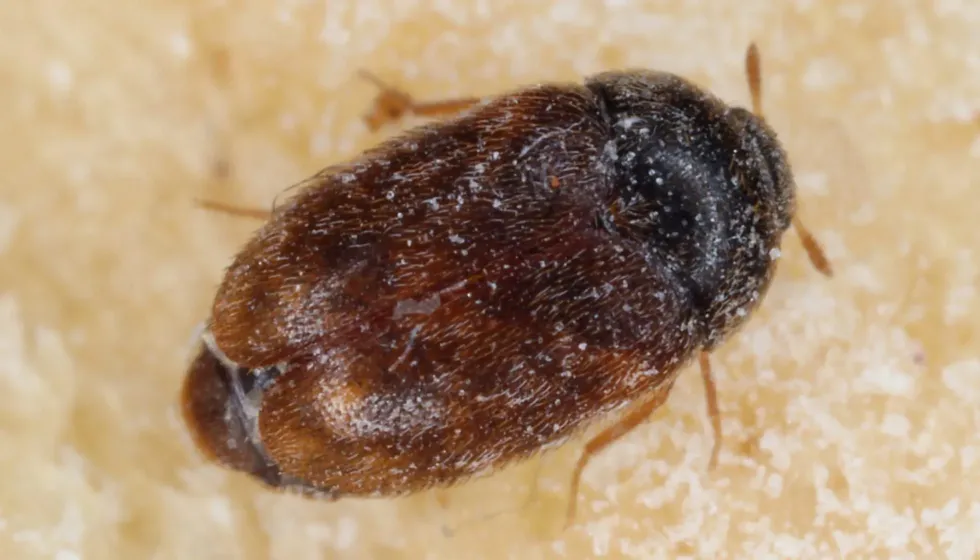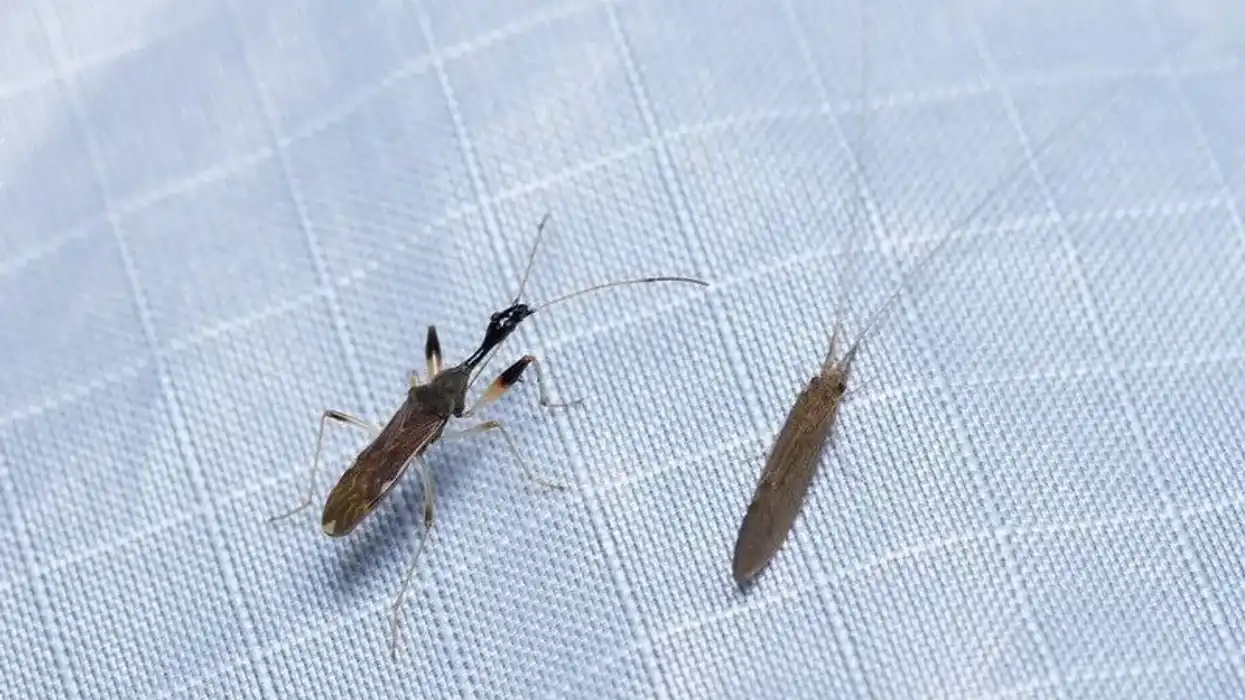The khapra beetle (Trogoderma granarium), also known as cabinet beetle, belongs to the family Dermestidae (skin beetles). This beetle originated from India.
They are on the list of the 100 worst invasive species in the world as they are difficult to control. The adult khapra beetle is reddish and brownish-colored. These are hardy creatures and can survive many insecticides.
There is a federal quarantine rule that restricts the entry of rice from countries with khapra beetle infestation into the United States. They belong to the Trogoderma genus, which consists of around 135 species of beetles across the world.
They also belong to the subfamily Megatominae, which consists of the popular stored-product and household pest beetles. There are around 27 recognized genera in this subfamily. Dermistidae family is not only known as skin beetle family but also known as hide or leather beetle, larder beetle, carpet beetle, and khapra beetle family.
These beetles are covered in setae or scales. These family beetles are destructive to several day-to-day items like cotton or silk.
If you liked these facts about the khapra beetle then you need to check out these water beetle and Christmas beetle facts on Kidadl.
Khapra Beetle Interesting Facts
What type of animal is a khapra beetle?
The khapra beetle (Trogoderma granarium, everts) is a cabinet, skin beetle, and stored-product pest of the order Coleoptera and phylum Arthropoda. They are pests of oilseeds, wheat barley oats, rye, rice, and dried food materials.
Their population rapidly grows in hot, dry conditions. This beetle is the worst and most destructive pest as they are difficult to control, as they can survive without food for a long time. This also builds their tolerance against fumigants and insecticides.
What class of animal does a khapra beetle belong to?
The khapra beetle (Trogoderma granarium, everts) belongs to the insects class of animals.
How many khapra beetles are there in the world?
The khapra beetle (Trogoderma granarium, everts) population count is not yet known. Since they grow rapidly and are now established in many parts of the world, it is difficult to track and control their growth.
Where does a khapra beetle live?
The khapra beetle (Trogoderma granarium, everts) is native species of India in South Asia. They are now found in a wide range of locations. They occupy many Asian, African, Mediterranean, and Middle Eastern countries.
What is a khapra beetle's habitat?
The range of habitat covered by the khapra beetles is around urban and agriculture fields. They occupy cracks and crevices, storages, animal holding facilities, and silos in this agriculture field. They occupy food storages that contains
Who do khapra beetles live with?
This beetle (khapra) lives and migrates in groups.
How long does a khapra beetle live?
The life cycle of this beetle (khapra) involves five larval instars. The adult lifespan is about 5 - 10 days.
How do they reproduce?
Five days after they emerge as adult khapra beetle the matind period starts. Females then secrete pheromones to attract males and less range of other females and mated males.
This is how the reproduction sites are established. The female beetle (khapra) needs to mate only once. At 104 F (40 C) oviposition takes place for three to four days and the pre-oviposition starts at 77 F (25 C).
The pre-oviposition days last for two to three days and oviposition lasts for 12 days. The female's abdomen is puffed with eggs.
There is very little or no effect of this temperature on the number of eggs laid. The female lays around 35 white to yellowish eggs, which are loosely scattered in a host material.
This female dies soon after the end of oviposition and males live around four days longer. The larval development stage of the khapra beetle life cycle does not take place at less than 70 F (21 C) temperature. This beetle has two types of genetic larvae, ones that cannot undergo facultative diapause and ones that can do so.
The latter is accelerated to diapause by severe conditions like crowding, temperature, and humidity. The larvae feed on grains, rice, rye, oats, and seeds.
When khapra beetle larva is almost mature, they leave their food and seek refuge in stored goods. Several larvae can take refuge together.
The larvae can survive for about nine months without food and live for six long years with food. In this stage, they are highly resistant to fumigants or insecticides.
In the pupal stage, the pupa remains inside the skin of the final stage instar larva. The pupa is unaffected by humidity. When adults emerge, the skins of the pupal are pushed to the posterior end of larval skins.
Adults can stay inside this skin for a day or more. Adults copulate as soon as they emerge.
What is their conservation status?
The conservation status of khapra beetle is listed as Not Evaluated.
Khapra Beetle Fun Facts
What do khapra beetles look like?
Adult beetles are reddish-brown with or without markings with darker brown pronotum. Adults are oval-shaped. Males are darker in color than females. They have small heads with median ocellus between their compound eyes.
There are 11 segments on the antennae, that are clubbed as three to five segments. The antennae fit into the ventral grooves present in the prothorax. Adults are covered in hair. The khapra beetle eggs are cylindrical.
More than half of the larvae's length consists tail made of hairs. Larvae are yellowish-white but the hairs and head are brown. The khapra beetle characteristics consist of varying body hairs. The hairs are either simple and stiff or barbed.
How cute are they?
The adult khapra beetle is a dangerous pest and is not considered cute.
How do they communicate?
The khapra beetle communicated through pheromone and chemical release,
How big is a khapra beetle?
Adult beetles measure up to 0.062-0.11 in (1.6-3 mm) in length. Larvae grow up to 0.19 in (5 mm) long. Females are larger than males. The biggest khapra beetle is 22 times smaller than the biggest ground beetle.
How fast can khapra beetles move?
The exact speed of khapra beetle is not known.
How much does a khapra beetle weigh?
Adults weigh up to 4.4 lb (0.02 mg). The khapra weighs two times heavier than dung beetles.
What are the male and female names of the species?
There is no specific name given to the female and male khapra beetle species.
What would you call a baby khapra beetle?
There is no specific name given to the baby khapra beetle. In their development stage, they are usually referred to as khapra beetle larvae.
What do they eat?
Khapra beetles feed on Stored grain products and seed, wheat kernels, whole barley flour, maize, barley, and oats. The larvae can go without food for a long time.
Are they harmful?
These beetles are not harmful to humans but are destructive pests that feed on dried plants and stored grain. However, if handled incorrectly, the larval skins can cause skin irritation, and if swallowed the hairs can use gastrointestinal irritation.
Would they make a good pet?
No, they would not make a good pet. These species are pests causing a lot of damage to the agriculture industry.
Did you know...
In 1953 a discovery of khapra beetles in California led to huge control and eradication efforts that extended till 1966, which cost $15 million to the government.
Even though they are robust beetles. Some predators are flies, wasps, and other beetles.
Why are khapra beetles bad?
In many countries, there are quarantine regulations to be followed to prevent khapra beetle infestation as they are very difficult to control. When these insects infest stored grains, these grains can be completely destroyed.
Khapra beetle economic damage impacts dry commodities of animal origin, seed viability, and trade. The reproduction is so rapid that a huge larvae population can be found on binned grain.
As the larvae seek dry conditions and cracks and crevices and stay there without food for years due to which they are pests worldwide. There are also negative khapra beetle effects caused indirectly.
How to get rid of khapra beetles?
Khapra beetle control is effective with the methyl bromide. In infested wheat stores in India, powdered neem has been used to control these pest species.
This neem powder only repels insects and usually does not kill insects in infested areas. Pest management research shows that Datura metel leaf extracts have a multi-generational and toxic impact on khapra beetle. Higher concentrations of these extracts increased the mortality rate among adults and offspring.
Efforts can be made to restrict infested goods from being exported and sea shipping containers decontaminated before reusing. The khapra infestation is an international and national emergency and calls for immediate action.
Here at Kidadl, we have carefully created lots of interesting family-friendly animal facts for everyone to discover! For more relatable content, check out these Hercules beetle facts and rhinoceros beetle facts pages.
You can even occupy yourself at home by coloring on one of our free printable Khapra beetle coloring pages.










